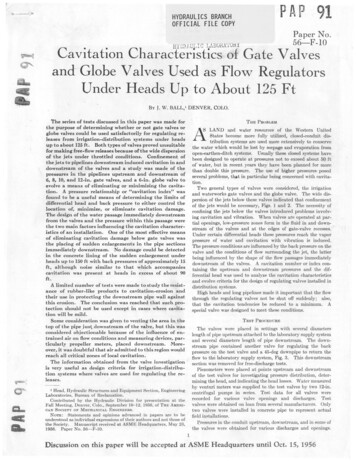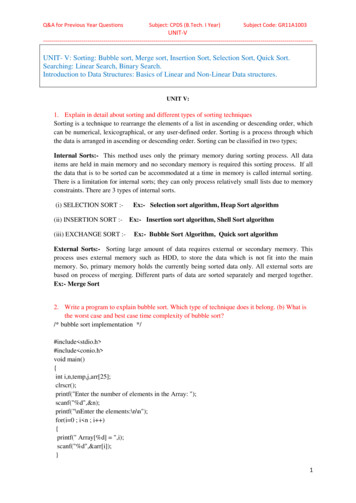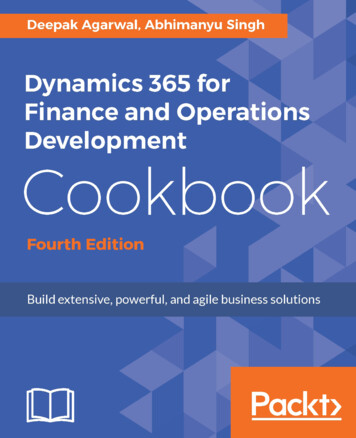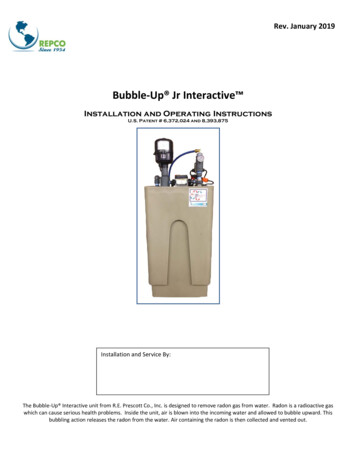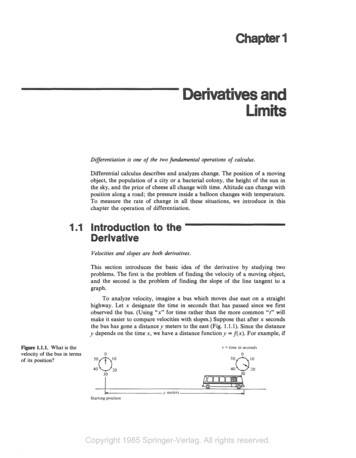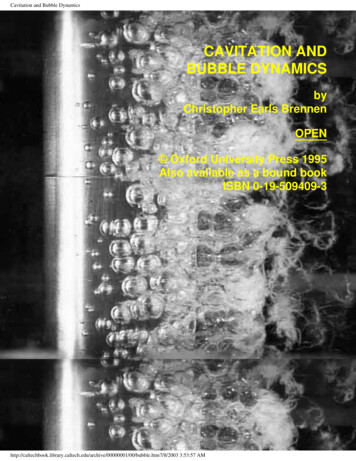
Transcription
Cavitation and Bubble DynamicsCAVITATION ANDBUBBLE DYNAMICSbyChristopher Earls BrennenOPEN Oxford University Press 1995Also available as a bound bookISBN u/archive/00000001/00/bubble.htm7/8/2003 3:53:57 AM
Contents - Cavitation and Bubble DynamicsCAVITATION AND BUBBLE DYNAMICSbyChristopher Earls Brennen Oxford University Press 1995PrefaceNomenclatureCHAPTER 1.PHASE CHANGE, NUCLEATION, ANDCAVITATION1.1 Introduction1.2 The Liquid State1.3 Fluidity and Elasticity1.4 Illustration of Tensile Strength1.5 Cavitation and Boiling1.6 Types of Nucleation1.7 Homogeneous Nucleation Theory1.8 Comparison with Experiments1.9 Experiments on Tensile Strength1.10 Heterogeneous Nucleation1.11 Nucleation Site Populations1.12 Effect of Contaminant Gas1.13 Nucleation in Flowing Liquids1.14 Viscous Effects in Cavitation Inception1.15 Cavitation Inception Measurements1.16 Cavitation Inception Data1.17 Scaling of Cavitation InceptionReferencesCHAPTER 2.SPHERICAL BUBBLE DYNAMICS2.1 Introduction2.2 Rayleigh-Plesset hive/00000001/00/content.htm (1 of 5)7/8/2003 3:53:59 AM
Contents - Cavitation and Bubble Dynamics2.3 Bubble Contents2.4 In the Absence of Thermal Effects2.5 Stability of Vapor/Gas Bubbles2.6 Growth by Mass Diffusion2.7 Thermal Effects on Growth2.8 Thermally Controlled Growth2.9 Nonequilibrium Effects2.10 Convective Effects2.11 Surface Roughening Effects2.12 Nonspherical PerturbationsReferencesCHAPTER 3.CAVITATION BUBBLE COLLAPSE3.1 Introduction3.2 Bubble Collapse3.3 Thermally Controlled Collapse3.4 Thermal Effects in Bubble Collapse3.5 Nonspherical Shape during Collapse3.6 Cavitation Damage3.7 Damage due to Cloud Collapse3.8 Cavitation Noise3.9 Cavitation LuminescenceReferencesCHAPTER 4.DYNAMICS OF OSCILLATING BUBBLES4.1 Introduction4.2 Bubble Natural Frequencies4.3 Effective Polytropic Constant4.4 Additional Damping Terms4.5 Nonlinear Effects4.6 Weakly Nonlinear Analysis4.7 Chaotic /archive/00000001/00/content.htm (2 of 5)7/8/2003 3:53:59 AM
Contents - Cavitation and Bubble Dynamics4.8 Threshold for Transient Cavitation4.9 Rectified Mass Diffusion4.10 Bjerknes ForcesReferencesCHAPTER 5.TRANSLATION OF BUBBLES5.1 Introduction5.2 High Re Flows around a Sphere5.3 Low Re Flows around a Sphere5.4 Marangoni Effects5.5 Molecular Effects5.6 Unsteady Particle Motions5.7 Unsteady Potential Flow5.8 Unsteady Stokes Flow5.9 Growing or Collapsing Bubbles5.10 Equation of Motion5.11 Magnitude of Relative Motion5.12 Deformation due to TranslationReferencesCHAPTER 6.HOMOGENEOUS BUBBLY FLOWS6.1 Introduction6.2 Sonic Speed6.3 Sonic Speed with Change of Phase6.4 Barotropic Relations6.5 Nozzle Flows6.6 Vapor/Liquid Nozzle Flow6.7 Flows with Bubble Dynamics6.8 Acoustics of Bubbly Mixtures6.9 Shock Waves in Bubbly Flows6.10 Spherical Bubble edu/archive/00000001/00/content.htm (3 of 5)7/8/2003 3:53:59 AM
Contents - Cavitation and Bubble DynamicsCHAPTER 7.CAVITATING FLOWS7.1 Introduction7.2 Traveling Bubble Cavitation7.3 Bubble/Flow Interactions7.4 Experimental Observations7.5 Large-Scale Cavitation Structures7.6 Vortex Cavitation7.7 Cloud Cavitation7.8 Attached or Sheet Cavitation7.9 Cavitating Foils7.10 Cavity ClosureReferencesCHAPTER 8.FREE STREAMLINE FLOWS8.1 Introduction8.2 Cavity Closure Models8.3 Cavity Detachment Models8.4 Wall Effects and Choked Flows8.5 Steady Planar Flows8.6 Some Nonlinear Results8.7 Linearized Methods8.8 Flat Plate Hydrofoil8.9 Cavitating Cascades8.10 Three-Dimensional Flows8.11 Numerical Methods8.12 Unsteady FlowsReferencesBack to front pageLast updated ive/00000001/00/content.htm (4 of 5)7/8/2003 3:53:59 AM
Contents - Cavitation and Bubble DynamicsChristopher E. ive/00000001/00/content.htm (5 of 5)7/8/2003 3:53:59 AM
Preface - Cavitation and Bubble Dynamics - Christopher E. BrennenCAVITATION AND BUBBLE DYNAMICSbyChristopher Earls Brennen Oxford University Press 1995Preface to the original OUP hardback editionThis book is intended as a combination of a reference book for those who work withcavitation or bubble dynamics and as a monograph for advanced students interested insome of the basic problems associated with this category of multiphase flows. A book likethis has many roots. It began many years ago when, as a young postdoctoral fellow at theCalifornia Institute of Technology, I was asked to prepare a series of lectures on cavitationfor a graduate course cum seminar series. It was truly a baptism by fire, for the audienceincluded three of the great names in cavitation research, Milton Plesset, Allan Acosta, andTheodore Wu, none of whom readily accepted superficial explanations. For that, I amimmensely grateful. The course and I survived, and it evolved into one part of a graduateprogram in multiphase flows.There are many people to whom I owe a debt of gratitude for the roles they played inmaking this book possible. It was my great good fortune to have known and studied withsix outstanding scholars, Les Woods, George Gadd, Milton Plesset, Allan Acosta, TedWu, and Rolf Sabersky. I benefited immensely from their scholarship and their friendship.I also owe much to my many colleagues in the American Society of Mechanical Engineerswhose insights fill many of the pages of this monograph. The support of my researchprogram by the Office of Naval Research is also greatly appreciated. And, of course, I feelhonored to have worked with an outstanding group of graduate students at Caltech,including Sheung-Lip Ng, Kiam Oey, David Braisted, Luca d'Agostino, Steven Ceccio,Sanjay Kumar, Douglas Hart, Yan Kuhn de Chizelle, Beth McKenney, Zhenhuan Liu, YiChun Wang, and Garrett Reisman, all of whom studied aspects of cavitating flows.The book is dedicated to Doreen, my companion and friend of over thirty years, whotolerated the obsession and the late nights that seemed necessary to bring it to completion.To her I owe more than I can tell.Christopher Earls Brennen, Pasadena, Calif.June 1994Preface to the Internet ive/00000001/00/preface.htm (1 of 2)7/8/2003 3:53:59 AM
Preface - Cavitation and Bubble Dynamics - Christopher E. BrennenThough my conversion of "Cavitation and Bubble Dynamics" from the hardback book toHTML is rough in places, I am so convinced of the promise of the web that I am pleasedto offer this edition freely to those who wish to use it. This new medium clearly involvessome advantages and some disadvantages. The opportunity to incorporate as many colorphotographs as I wish (and perhaps even some movies) is a great advantage and one that Iintend to use in future modifications. Another advantage is the ability to continuallycorrect the manuscript though I will not undertake the daunting task of trying to keep it upto date. A disadvantage is the severe limitation in HTML on the use of mathematicalsymbols. I have only solved this problem rather crudely and apologize for this roughnessin the manuscript.In addition to those whom I thanked earlier, I would like to express my thanks to myacademic home, the California Institute of Technology, for help in providing the facilitiesused to effect this conversion, and to the Sherman-Fairchild Library at Caltech whose staffprovided much valuable assistance. I am also most grateful to Oxford University Press fortheir permission to place this edition on the internet.Christopher Earls Brennen, Pasadena, Calif.July 2002Back to table of hive/00000001/00/preface.htm (2 of 2)7/8/2003 3:53:59 AM
Nomenclature - Cavitation and Bubble Dynamics - Christopher E. BrennenCAVITATION AND BUBBLE DYNAMICSbyChristopher Earls Brennen Oxford University Press 1995NomenclatureROMAN LETTERSaAbBcckAmplitude of wave-like disturbanceCross-sectional area or cloud radiusBody half-widthTunnel half-widthConcentration of dissolved gas in liquid, speed of sound, chordcPSpecific heat at constant pressureCDDrag coefficientCLLift coefficientPhase velocity for wavenumber k,Unsteady lift coefficientsCMMoment coefficient,Unsteady moment coefficientsCijLift/drag coefficient matrixCpCoefficient of pressureCpminMinimum coefficient of pressuredDfCavity half-width, blade thickness to spacing ratioMass diffusivityFrequency in Hz.fComplex velocity potential, φ iψfNA thermodynamic property of the phase or component, NFrggxFroude numberAcceleration due to gravityComponent of the gravitational acceleration in direction, 000001/00/nomen.htm (1 of 6)7/8/2003 3:54:00 AM
Nomenclature - Cavitation and Bubble Dynamics - Christopher E. BrennengN(f)A thermodynamic property of the phase or component, NSpectral density function of soundhHSpecific enthalpy, wetted surface elevation, blade tip spacingHenry's law constantHmi,j,kiIHaberman-Morton number, normally g 4/ρS3IndicesSquare root of -1 in free streamline analysisAcoustic impulseI*Dimensionless acoustic impulse, 4πI {\cal R} / ρL U RH2IKiKelvin impulse vectorjkkNSquare root of -1Boltzmann's constant, polytropic constant or wavenumberThermal conductivity or thermodynamic property of NKGGas constantKijAdded mass coefficient matrix, 3Mij/4ρπR3KcKeulegan-Carpenter numberKnKnudsen number, λ/2RTypical dimension in the flow, cavity half-lengthLatent heat of vaporizationMass LmmGMass of gas in bubblempMass of particleMijAdded mass matrixnN(R)Index used for harmonics or number of sites per unit areaNumber density distribution function of RCavitation event rateNuppaNusselt numberPressurepsRoot mean square sound pressurepSA sound pressure levelpGPartial pressure of gasRadiated acoustic hive/00000001/00/nomen.htm (2 of 6)7/8/2003 3:54:00 AM
Nomenclature - Cavitation and Bubble Dynamics - Christopher E. BrennenPPseudo-pressurePePeclet number, usually WR/αLqqcMagnitude of velocity vectorQrRRBSource strengthRadial coordinateBubble radiusRHHeadform radiusRMMaximum bubble radiusRNCavitation nucleus radiusRPNucleation site radiusFree surface velocityEquivalent volumetric radius, [3τ/4π]1/3Distance to measurement pointReReynolds number, usually 2WR/νLssSStttRCoordinate measured along a streamline or surfaceSpecific entropySurface tensionStrouhal number, 2fR/WTimet*Dimensionless time, t/tRTu,v,wuiTemperatureVelocity components in cartesian coordinatesur,uθVelocity components in polar coordinatesu′Perturbation velocity in x direction, u-U U, UiFluid velocity and velocity vector in absence of particleV, ViAbsolute velocity and velocity vector of particleU Velocity of upstream uniform flowwwComplex conjugate velocity, u-ivDimensionless relative velocity, W/W WRelative velocity of particleRelaxation time for relative motionVelocity ve/00000001/00/nomen.htm (3 of 6)7/8/2003 3:54:00 AM
Nomenclature - Cavitation and Bubble Dynamics - Christopher E. BrennenW Terminal velocity of particleWeWeber number, 2ρW2R/SComplex position vector, x iyzGREEK LETTERSα Thermal diffusivity, volume fraction, angle of incidenceβCascade stagger angle, other local variablesγRatio of specific heats of gasΓCirculation, other local parametersδBoundary layer thickness or increment of frequencyδD Dissipation coefficientδT Thermal boundary layer thicknessεFractional volumeζComplex variable, ξ iηηBubble population per unit liquid volumeηCoordinate in ζ-planeθAngular coordinate or direction of velocity vectorκBulk modulus of compressibilityλMean free path of molecules or particlesΛ Accommodation coefficient Dynamic viscosityνKinematic viscosityξCoordinate in ζ-planeLogarithmic hodograph variable, χ iθρDensityσCavitation numberσc Choked cavitation numberσij Stress tensorΣThermal parameter in bubble growthτøVolume of particle or bubbleVelocity potentialø′ Acceleration chive/00000001/00/nomen.htm (4 of 6)7/8/2003 3:54:00 AM
Nomenclature - Cavitation and Bubble Dynamics - Christopher E. BrennenφFractional perturbation in bubble radiusΦ Potential energyχ log(qc/ w )ψ Stream functionω Radian frequencyω* Reduced frequency, ωc/U SUBSCRIPTSOn any variable, Q:QoInitial value, upstream value or reservoir valueQ1,Q2,Q3 Components of Q in three Cartesian directionsQ1,Q2Values upstream and downstream of a shockQ Value far from the bubble or in the upstream flowQBValue in the bubbleQCCritical values and values at the critical pointQEEquilibrium value or value on the saturated liquid/vapor lineQGValue for the gasQiComponents of vector QQijComponents of tensor QQLSaturated liquid valueQnHarmonic of order nQPPeak valueQSValue on the interface or at constant entropyQVSaturated vapor valueQ*Value at the throatSUPERSCRIPTS AND OTHER QUALIFIERSOn any variable, Q:Mean value of Q or complex conjugate of 000001/00/nomen.htm (5 of 6)7/8/2003 3:54:00 AM
Nomenclature - Cavitation and Bubble Dynamics - Christopher E. BrennenComplex amplitude of oscillating QLaplace transform of Q(t)Coordinate with origin at image pointRate of change of Q with timeSecond derivative of Q with timeQ ,Q- Values of Q on either side of a cut in a complex planeδQRe{Q}Im{Q}Small change in QReal part of QImaginary part of QUNITSIn most of this book, the emphasis is placed on the nondimensional parameters that governthe phenomenon being discussed. However, there are also circumstances in which weshall utilize dimensional thermodynamic and transport properties. In such cases theInternational System of Units will be employed using the basic units of mass (kg), length(m), time (s), and absolute temperature (K); where it is particularly convenient units suchas a joule (kg m2/s2) will occasionally be used.Back to table of contentsLast updated 12/1/00.Christopher E. ive/00000001/00/nomen.htm (6 of 6)7/8/2003 3:54:00 AM
Chapter 1 - Cavitation and Bubble Dynamics - Christopher E. BrennenCAVITATION AND BUBBLE DYNAMICSbyChristopher Earls Brennen Oxford University Press 1995CHAPTER 1.PHASE CHANGE, NUCLEATION, AND CAVITATION1.1 INTRODUCTIONThis first chapter will focus on the mechanisms of formation of two-phase mixtures of vaporand liquid. Particular attention will be given to the process of the creation of vapor bubbles ina liquid. In doing so we will attempt to meld together several overlapping areas of researchactivity. First, there are the studies of the fundamental physics of nucleation as epitomized bythe books of Frenkel (1955) and Skripov (1974). These deal largely with very pure liquidsand clean environments in order to isolate the behavior of pure liquids. On the other hand,most engineering systems are impure or contaminated in ways that have important effects onthe process of nucleation. The later part of the chapter will deal with the physics ofnucleation in such engineering environments. This engineering knowledge tends to bedivided into two somewhat separate fields of interest, cavitation and boiling. A rough butuseful way of distinguishing these two processes is to define cavitation as the process ofnucleation in a liquid when the pressure falls below the vapor pressure, while boiling is theprocess of nucleation that ocurs when the temperature is raised above the saturated vapor/liquid temperature. Of course, from a basic physical point of view, there is little differencebetween the two processes, and we shall attempt to review the two processes of nucleationsimultaneously. The differences in the two processes occur because of the differentcomplicating factors that occur in a cavitating flow on the one hand and in the temperaturegradients and wall effects that occur in boiling on the other hand. The last sections of thisfirst chapter will dwell on some of these complicating factors.1.2 THE LIQUID STATEAny discussion of the process of phase change from liquid to gas or vice versa mustnecessarily be preceded by a discussion of the liquid state. Though simple kinetic theoryunderstanding of the gaseous state is sufficient for our purposes, it is necessary to dwellsomewhat longer on the nature of the liquid state. In doing so we shall follow Frenkel (1955),though it should also be noted that modern studies are usually couched in terms of statisticalmechanics (for example, Carey ve/00000001/00/chap1.htm (1 of 33)7/8/2003 3:54:07 AM
Chapter 1 - Cavitation and Bubble Dynamics - Christopher E. BrennenFigure 1.1 Typical phase diagrams.Our discussion will begin with typical phase diagrams, which, though idealized, are relevantto many practical substances. Figure 1.1 shows typical graphs of pressure, p, temperature, T,and specific volume, V, in which the state of the substance is indicated. The triple point isthat point in the phase diagram at which the solid, liquid, and vapor states coexist; that is tosay the substance has three alternative stable states. The saturated liquid/vapor line (orbinodal) extends from this point to the critical point. Thermodynamically it is defined by thefact that the chemical potentials of the two coexisting phases must be equal. On this line thevapor and liquid states represent two limiting forms of a single amorphous'' state, one ofwhich can be obtained from the other by isothermal volumetric changes, leading throughintermediate but unstable states. To quote Frenkel (1955), Owing to this instability, theactual transition from the liquid state to the gaseous one and vice versa takes place not alonga theoretical isotherm (dashed line, right, Figure 1.1), but along a horizontal isotherm (solidline), corresponding to the splitting up of the original homogeneous substance into twodifferent coexisting phases.'' The critical point is that point at which the maxima and minimain the theoretical isotherm vanish and the discontinuity disappears.The line joining the maxima in the theoretical isotherms is called the vapor spinodal line; theline joining the minima is called the liquid spinodal line. Clearly both spinodals end at thecritical point. The two regions between the spinodal lines and the saturated (or binodal) linesare of particular interest because the conditions represented by the theoretical isotherm withinthese regions can be realized in practice under certain special conditions. If, for example, apure liquid at the state A (Figure 1.1) is depressurized at constant temperature, then ive/00000001/00/chap1.htm (2 of 33)7/8/2003 3:54:07 AM
Chapter 1 - Cavitation and Bubble Dynamics - Christopher E. Brennenthings may happen when the pressure is reduced below that of point B (the saturated vaporpressure). If sufficient numbers of nucleation sites of sufficient size are present (and thisneeds further discussion later) the liquid will become vapor as the state moves horizontallyfrom B to C, and at pressure below the vapor pressure the state will come to equilibrium inthe gaseous region at a point such as E. However, if no nucleation sites are present, thedepressurization may lead to continuation of the state down the theoretical isotherm to a pointsuch as D, called a metastable state'' since imperfections may lead to instability andtransition to the point E. A liquid at a point such as D is said to be in tension, the pressuredifference between B and D being the magnitude of the tension. Of course one could alsoreach a point like D by proceeding along an isobar from a point such as D′ by increasing thetemperature. Then an equivalent description of the state at D is to call it superheated and torefer to the difference between the temperatures at D and D′ as the superheat.In an analogous way one can visualize cooling or pressurizing a vapor that is initially at astate such as F and proceeding to a metastable state such as F′ where the temperaturedifference between F and F′ is the degree of subcooling of the vapor.1.3 FLUIDITY AND ELASTICITYBefore proceding with more detail, it is valuable to point out several qualitative features ofthe liquid state and to remark on its comparison with the simpler crystalline solid or gaseousstates. The first and most obvious difference between the saturated liquid and saturated vaporstates is that the density of the liquid remains relatively constant and similar to that of thesolid except close to the critical point. On the other hand the density of the vapor is differentby at least 2 and up to 5 or more orders of magnitude, changing radically with temperature.Since it will also be important in later discussions, a plot of the ratio of the saturated liquiddensity to the saturated vapor density is included as Figure 1.2 for a number of differentfluids. The ratio is plotted against a non-dimensional temperature, θ T/TC where T is theactual temperature and TC is the critical temperature.Figure 1.2 Ratio ofsaturated liquiddensity to saturatedvapor density as afunction oftemperature forvarious edu/archive/00000001/00/chap1.htm (3 of 33)7/8/2003 3:54:07 AM
Chapter 1 - Cavitation and Bubble Dynamics - Christopher E. BrennenSecond, an examination of the measured specific heat of the saturated liquid reveals that thisis of the same order as the specific heat of the solid except at high temperature close to thecritical point. The above two features of liquids imply that the thermal motion of the liquidmolecules is similar to that of the solid and involves small amplitude vibrations about a quasiequilibrium position within the liquid. Thus the arrangement of the molecules has greatersimilarity with a solid than with a gas. One needs to stress this similarity with a solid tocounteract the tendency to think of the liquid state as more akin to the gaseous state than tothe solid state because in many observed processes it possesses a dominant fluidity ratherthan a dominant elasticity. Indeed, it is of interest in this regard to point out that solids alsopossess fluidity in addition to elasticity. At high temperatures, particularly above 0.6 or 0.7 ofthe melting temperature, most crystalline solids exhibit a fluidity known as creep. When thestrain rate is high, this creep occurs due to the nonisotropic propagation of dislocations (thisbehavior is not like that of a Newtonian liquid and cannot be characterized by a ve/00000001/00/chap1.htm (4 of 33)7/8/2003 3:54:07 AM
Chapter 1 - Cavitation and Bubble Dynamics - Christopher E. Brennenviscosity). At low strain rates, high-temperature creep occurs due simply to the isotropicmigration of molecules within the crystal lattice due to the thermal agitation. This kind ofcreep, which is known as diffusion creep, is analogous to the fluidity observed in mostliquids and can be characterized by a simple Newtonian viscosity.Following this we may ask whether the liquid state possesses an elasticity even though suchelasticity may be dominated by the fluidity of the liquid in many physical processes. In boththe liquid and solid states one might envisage a certain typical time, tm, for the migration of amolecule from one position within the structure of the substance to a neighboring position;alternatively one might consider this typical time as characterizing the migration of a hole''or vacancy from one position to another within the structure. Then if the typical time, t,associated with the applied force is small compared with tm, the substance will not be capableof permanent deformation during that process and will exhibit elasticity rather than fluidity.On the other hand if t»tm the material will exhibit fluidity. Thus, though the conclusion isoverly simplistic, one can characterize a solid as having a large tm and a liquid as having asmall tm relative to the order of magnitude of the typical time, t, of the applied force. Oneexample of this is that the earth's mantle behaves to all intents and purposes as solid rock inso far as the propagation of seismic waves is concerned, and yet its fluid-like flow over longgeological times is responsible for continental drift.The observation time, t, becomes important when the phenomenon is controlled by stochasticevents such as the diffusion of vacancies in diffusion creep. In many cases the process ofnucleation is also controlled by such stochastic events, so the observation time will play asignificant role in determining this process. Over a longer period of time there is a greaterprobability that vacancies will coalesce to form a finite vapor pocket leading to nucleation.Conversely, it is also possible to visualize that a liquid could be placed in a state of tension(negative pressure) for a significant period of time before a vapor bubble would form in it.Such a scenario was visualized many years ago. In 1850, Berthelot (1850) subjected purifiedwater to tensions of up to 50 atmospheres before it yielded. This ability of liquids towithstand tension is very similar to the more familiar property exhibited by solids and is amanifestation of the elasticity of a liquid.1.4 ILLUSTRATION OF TENSILE STRENGTHFrenkel (1955) illustrates the potential tensile strength of a pure liquid by means of a simple,but instructive calculation. Consider two molecules separated by a variable distance, s. Thetypical potential energy, Φ, associated with the intermolecular forces has the form shown inFigure 1.3. Equilibrium occurs at the separation, xo, typically of the order of 10-10m. Theattractive force, F, between the molecules is equal to Φ/ x and is a maximum at somedistance, x1, where typically x1/xo is of the order of 1.1 or 1.2. In a bulk liquid or solid thiswould correspond to a fractional volumetric expansion, V/Vo, of about one-third.Consequently the application of a constant tensile stress equal to that pertinent at x1 e/00000001/00/chap1.htm (5 of 33)7/8/2003 3:54:07 AM
Chapter 1 - Cavitation and Bubble Dynamics - Christopher E. Brennencompletely rupture the liquid or solid since for x x1 the attractive force is insufficient tocounteract that tensile force. In fact, liquids and solids have compressibility moduli, κ, whichare usually in the range of 1010 to 1011 kg/m s2 and since the pressure, p -κ( V/Vo), itfollows that the typical pressure that will rupture a liquid, pT, is -3 109 to -3 1010 kg/m s2.In other words, we estimate on this basis that liquids or solids should be able to withstandtensile stresses of 3 104 to 3 105 atmospheres! In practice solids do not reach these limits(the rupture stress is usually about 100 times less) because of stress concentrations; that is tosay, the actual stress encountered at certain points can achieve the large values quoted aboveat certain points even when the overall or globally averaged stress is still 100 times smaller.In liquids the large theoretical values of the tensile strength defy all practical experience; thisdiscrepancy must be addressed.Figure 1.3 Intermolecularpotential.It is valuable to continue the above calculation one further step (Frenkel 1955). The elasticenergy stored per unit volume of the above system is given by κ( V)2/2Vo or p Vo/2.Consequently the energy that one must provide to pull apart all the molecules and vaporizethe liquid can be estimated to be given by pT /6 or between 5 108 and 5 109 kg/m s2. Thisis in agreement with the order of magnitude of the latent heat of vaporization measured formany liquids. Moreover, one can correctly estimate the order of magnitude of the criticaltemperature, TC, by assuming that, at that point, the kinetic energy of heat motion, kTC permolecule (where k is Boltzmann's constant, 1.38 10-23 kg m2/s2 K) is equal to the energyrequired to pull all the molecules apart. Taking a typical 1030 molecules per m3, this impliesthat TC is given by equating the kinetic energy of the thermal motions per unit volume, or1.38 107 TC, to pT /6. This yields typical values of TC of the order of 30 300 K, which isin accord with the order of magnitude of the actual values. Consequently we find that thissimplistic model presents a dilemma because though it correctly predicts the order ofmagnitude of the latent heat of vaporization and the critical temperature, it fails dismally topredict the tensile strength that a liquid can withstand. One must conclude that unlike 00000001/00/chap1.htm (6 of 33)7/8/2003 3:54:07 AM
Chapter 1 - Cavitation and Bubble Dynamics - Christopher E. Brennenlatent heat and critical temperature, the tensile strength is determined by weaknesses at pointswithin the liquid. Such weaknesses are probably ephemeral and difficult to quantify, sincethey could be caused by minute impurities. This difficulty and the dependence on the time ofapplication of the tension greatly complicate any theoretical evaluation of the tensile strength.1.5 CAVITATION AND BOILINGAs we discussed in section 1.2, the tensile strength of a liquid can be manifest in at least twoways:1. A liquid at constant temperature could be subjected to a decreasing pressure, p, whichfalls below the saturated vapor pressure, pV. The value of (pV -p) is called the tension, p, and the magnitude at which rupture occurs is the tensile strength of the liquid, pC. The process of rupturing a liquid by decrease in pressure at roughly constantliquid temperature is often called cavitation.2. A liquid at constant pressure may be subjected to a temperature, T, in excess of thenormal saturation temperature, TS. The value of T T-TS is the superheat, and thepoint at which vapor is formed, TC, is called the critical superheat. The process ofrupturing a liquid by increasing
7.8 Attached or Sheet Cavitation 7.9 Cavitating Foils 7.10 Cavity Closure References CHAPTER 8. FREE STREAMLINE FLOWS 8.1 Introduction 8.2 Cavity Closure Models 8.3 Cavity Detachment Models 8.4 Wall Effects and Choked Flows 8.5 Steady Planar Flows 8.6 Some Nonlinear Results 8.7 Linearized Methods 8.8 Flat Plate Hydrofoil 8.9 Cavitating Cascades
